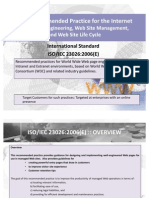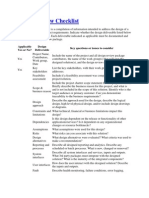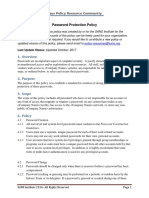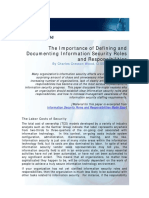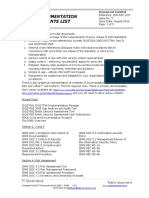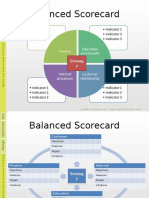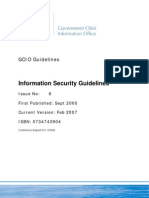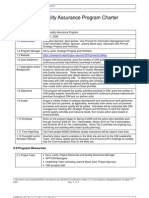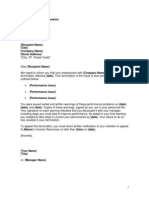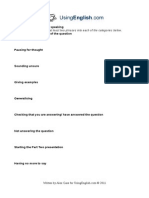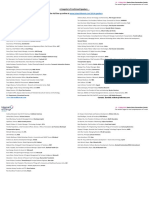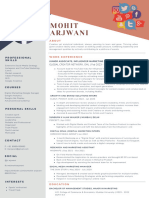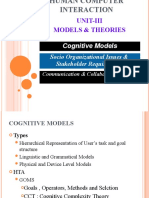15 Question SharePoint Risk Assessment
15 Question SharePoint Risk Assessment
Uploaded by
Gaurav AgarwalCopyright:
Available Formats
15 Question SharePoint Risk Assessment
15 Question SharePoint Risk Assessment
Uploaded by
Gaurav AgarwalOriginal Description:
Copyright
Available Formats
Share this document
Did you find this document useful?
Is this content inappropriate?
Copyright:
Available Formats
15 Question SharePoint Risk Assessment
15 Question SharePoint Risk Assessment
Uploaded by
Gaurav AgarwalCopyright:
Available Formats
Q1
Category Security policy
Q2 Q3
Permissions management Hardening
Assessment Question: Answer: Has the organization created specific SharePoint governance and security policies, and have users and administrators been made aware of them? Have IT security staff been involved in the development of security policies for this site, and for SharePoint generally in the organization? Please describe the permissions structure used in creation of this SharePoint site/sub-sites. Do system hardening standards exist for SharePoint sites, and are they implemented for this SharePoint site? If so, please identify the hardening practices that have been used in creation of this SharePoint ifrastructure. Include here any antimalware solutions deployed on IIS or SharePoint servers. Please describe the network security controls deployed that help secure the SharePoint sites/servers. Include such things as external/internal firewalls, intrusion prevention systems, web application firewalls, and the like. Is audit enabled for all SharePoint system components, are the audit logs captured in such a way so as to be immutable, and is there a regular audit review process in place? Please also note whether SharePoint administrators can easily enable/disable audit collection, and whether such configuration changes are recorded. Please identify all native SharePoint security controls which are enabled for this SharePoint site, along with all 3rd party security controls which have been implemented for this site. Include any SharePoint permissions products, audit products, anti-malware products, encryption products, and rights management products in use. Have IT security staff been involved in the selection, deployment, and test of security controls for this site, and for SharePoint generally in the organization? Please fully describe the SharePoint topology, including all IIS, SharePoint, database/RBS, backup/archive, index, search and other servers used in delivery of the SharePoint site, all internal/external interfaces, and how they relate to the rest of the internal/external networks with access. Does this site store compliance-regulated content of any of the following types: healthcare information (HIPAA/ePHI), credit card data (PCI DSS regulated cardholder data), personally identifiable information (PII, state data breach laws), export controlled information (EAR/ITAR regulated information), customer financial information (GLBA regulated customer account information), FDA/pharmaceutical regulated information (21 CFR Part 11), other? If so, please identify the content type/regulation, and describe the security controls employed to achieve compliance, and the content file type, quantity, and location in site. Please describe the various use cases, user communities, and the content stored by them in these SharePoint sites. Please specifically identify any sensitive content that is known to be stored in these sites, including, for example, intellectual property, human resources information, customer information, prospect databases, customer lists, or other sensitive/secret information. Please also identify if regular content scanning is performed on this site. Please think through and identify internal and external threats to the data and content residing in these SharePoint sites. These can include privileged employees, administrators, disgruntled IT staff, external hackers, competitors, employee errors, threats to backup data, theft of servers, and any other threat that you perceive to be relevant for these sites. It is helpful to rank order the threats according to your perception of liklihood of occurence. Please identify all disaster recovery and business continuity plans and procedures that are put in place for this SharePoint site, including backups/offsite storage. Please describe the identity and access management in use on this SharePoint site. Note whether identities and group privileges are administered via AD groups, local SharePoint groups, or claims/federation. Do any existing security controls enforce separation of duties, least privilege, and need to know, specifically relating to permissions, identity, and access to sensitive content for administrators on this SharePoint site? If yes, please identify and describe these controls, and how they are managed and administered.
Q4 Q5
Network Audit
Q6
Controls
Q7
Topology
Q8
Compliance
Q9
Content
Q10
Threats
Q11 Q12 Q13
DR/BCP Identity
Q14
Separation of duties, least privilege, need to know enforcement Impact Describe the impact to the business/department that would be realized if this SharePoint site was unavailable, or if SharePoint content was lost, stolen, altered, or unavailable. Include some thought on the impact of a security breach of this site/content- what would the impact to the business be, including breach notification costs and impacts.
Q15
Patch management Describe the patch management approach used on SharePoint servers.
Caveats and Usage notes: This simple SharePoint risk assessment should be used to gain a preliminary understanding of risks to SharePoint sites and information. Because SharePoint deployments vary widely in terms of whether they are internal, external, or internet-facing, and what sort of users and content are involved, etc., the assessment should be individually used for each different deployment scenario. Because this is a high-level risk assessment, and because the relevance of many of the questions and answers will vary considerably depending on the use case, user base, content types, and topology, no attempt has been made to make the results measurable into Low-Medium-High, or a more quantitative risk measurement. Our suggestion is that SharePoint administrators might want to work with your information security or risk management teams to tailor the assessment, and to discuss the meaning of the findings. CipherPoint Software (www.cipherpoint.com) is happy to make this high-level SharePoint risk assessment freely available to the SharePoint community. You are free to use or modify it as you see fit. If you develop other new assessment questions, we'd ask that you consider contributing them to the SharePoint community via the community security site (www.sharepointdefenseindepth.com) so that we may add them to a future version of this template. Disclaimer, use of this risk assessment template provides no assurance of security.
You might also like
- SharePoint Adoption PlaybookDocument30 pagesSharePoint Adoption Playbookaelmoro100% (1)
- SharePoint2010 Permissions MatrixDocument11 pagesSharePoint2010 Permissions MatrixGaurav AgarwalNo ratings yet
- m365 Project CharterDocument11 pagesm365 Project Charterbhavesh_pathak100% (1)
- Implementation Readiness Checklist: Hardware Asset ManagementDocument16 pagesImplementation Readiness Checklist: Hardware Asset Managementroben parsieNo ratings yet
- Change Management PolicyDocument2 pagesChange Management Policyf1sh01No ratings yet
- SharePoint Configuration Guidance For 21 CFR Part 11 ComplianceDocument72 pagesSharePoint Configuration Guidance For 21 CFR Part 11 CompliancewiwiwoNo ratings yet
- Work Station SecurityDocument3 pagesWork Station SecurityspNo ratings yet
- Doc02 - ISO 27001-2013 ISMS Manual TOPDocument22 pagesDoc02 - ISO 27001-2013 ISMS Manual TOPIRIE100% (1)
- ISO 23026 5minDocument9 pagesISO 23026 5minKalpana SupeNo ratings yet
- IT Audit FormatDocument15 pagesIT Audit FormatAnonymous 9d1jFvNo ratings yet
- Fed RampDocument4 pagesFed RampRihana KhatunNo ratings yet
- Design Review ChecklistDocument3 pagesDesign Review ChecklistGaurav AgarwalNo ratings yet
- BFC PresentationDocument28 pagesBFC Presentationescarcha56No ratings yet
- Is Elect 1 Prelim ExamDocument2 pagesIs Elect 1 Prelim ExamKristine Lily Ontog- Francisco0% (1)
- What Is Governance in Share Point 2013Document1 pageWhat Is Governance in Share Point 2013Foxman2kNo ratings yet
- Information Logging Standard: 1. OverviewDocument4 pagesInformation Logging Standard: 1. OverviewSilverNo ratings yet
- Computer AuditDocument8 pagesComputer AuditReycelyn BallesterosNo ratings yet
- It Security Audit Plan and Deliver Able Stem PlatesDocument2 pagesIt Security Audit Plan and Deliver Able Stem Platesrajesh35techieNo ratings yet
- Chapter 8 SDLCDocument14 pagesChapter 8 SDLCRichard Ngalu YalakwansoNo ratings yet
- Password Protection PolicyDocument3 pagesPassword Protection PolicyRahul GargNo ratings yet
- Change ManagementDocument5 pagesChange Managementr.jeyashankar9550100% (1)
- Change Management PolicyDocument7 pagesChange Management PolicyErvin PregNo ratings yet
- ISO27k Model Policy On Change Management and ControlDocument10 pagesISO27k Model Policy On Change Management and Controlowais800No ratings yet
- Security Roles and ResponsibilitiesDocument8 pagesSecurity Roles and Responsibilitieshosny1234No ratings yet
- Health IT Security Risk Assessment ToolDocument57 pagesHealth IT Security Risk Assessment ToolTUP BOX100% (1)
- SharePoint Governance Plan (Maven) PDFDocument21 pagesSharePoint Governance Plan (Maven) PDFAshley DavisNo ratings yet
- SharePoint Communication Plan TemplateDocument5 pagesSharePoint Communication Plan Templatenshbolu437No ratings yet
- Information Security Policy: 1. Purpose and ScopeDocument10 pagesInformation Security Policy: 1. Purpose and Scopepranaylin@gmail.comNo ratings yet
- Penetration Testing OverviewDocument4 pagesPenetration Testing OverviewY4kk0_Sp4rr0wNo ratings yet
- ISO 27001 PresentationDocument9 pagesISO 27001 PresentationRamyNo ratings yet
- Mapping 27001 - 17799Document27 pagesMapping 27001 - 17799anpinom24No ratings yet
- Information Security Policy A Complete Guide - 2019 EditionFrom EverandInformation Security Policy A Complete Guide - 2019 EditionNo ratings yet
- Sample Project PlanDocument5 pagesSample Project PlanchamzowxexyNo ratings yet
- Iso27002 Documentation Toolkit Contents List: Document ControlDocument5 pagesIso27002 Documentation Toolkit Contents List: Document Controlharis pratamaNo ratings yet
- SharePoint Interview QuestionsDocument10 pagesSharePoint Interview Questionsapi-19796528No ratings yet
- Balanced Scorecard: Strateg yDocument12 pagesBalanced Scorecard: Strateg yasesorNo ratings yet
- SharePoint 2013 Trace MatrixDocument3 pagesSharePoint 2013 Trace MatrixakbarmulangathNo ratings yet
- ITSM Training BrochureDocument55 pagesITSM Training Brochurevijayalakshmis76No ratings yet
- 27001-2013 To Cybersecurity Framework-1.0Document29 pages27001-2013 To Cybersecurity Framework-1.0Alex MejiaNo ratings yet
- Mandatory Information Security Management System Documents Required For ISO/IEC 27001 CertificationDocument7 pagesMandatory Information Security Management System Documents Required For ISO/IEC 27001 CertificationA ChatterjeeNo ratings yet
- Implement The Following SharePoint Security Best Practices in 2023Document5 pagesImplement The Following SharePoint Security Best Practices in 2023moony30No ratings yet
- How To Do A General IT ContrDocument46 pagesHow To Do A General IT ContrNicolas Astudillo100% (2)
- Deployment Guide For SharePoint 2013 PreviewDocument407 pagesDeployment Guide For SharePoint 2013 PreviewqarjamiNo ratings yet
- Sharepoint Knowledge BaseDocument716 pagesSharepoint Knowledge BaseCG HedmannNo ratings yet
- IT Availability and Capacity Policy and ProcedureDocument25 pagesIT Availability and Capacity Policy and Procedureislam108No ratings yet
- Desktop Vulnerability Scan Remediation PlanDocument2 pagesDesktop Vulnerability Scan Remediation PlanChandra SekharNo ratings yet
- Audit of Business Continuity Planning PDFDocument22 pagesAudit of Business Continuity Planning PDFNishimaNo ratings yet
- Course 20339-1A - Planning and Administering SharePoint 2016Document8 pagesCourse 20339-1A - Planning and Administering SharePoint 2016Ashish Kolambkar0% (1)
- IT SecurityDocument18 pagesIT SecurityMestar PerfectNo ratings yet
- Risk Management FrameworkDocument4 pagesRisk Management FrameworkMudrikaNo ratings yet
- CMMI ArtifactDocument2 pagesCMMI ArtifactsivaniranjanNo ratings yet
- InformationSecurityGuidelineV1 1Document111 pagesInformationSecurityGuidelineV1 1Diego Fernando Quiceno CortesNo ratings yet
- Technology Life CycleDocument8 pagesTechnology Life CycleAbdul AzeezNo ratings yet
- 7 Strategies For Successful IT Change ManagementDocument11 pages7 Strategies For Successful IT Change ManagementAsad Quraishi100% (5)
- IT Security Management - IsMSDocument53 pagesIT Security Management - IsMSRavi Raman100% (1)
- Information Security ManualDocument19 pagesInformation Security ManualTrivesh SharmaNo ratings yet
- Isca CH 4 BCP PMDocument18 pagesIsca CH 4 BCP PMPabitra Kumar PrustyNo ratings yet
- IT Security Audit GuidelineDocument31 pagesIT Security Audit GuidelineAneuxAgamNo ratings yet
- MyDLP Administration GuideDocument84 pagesMyDLP Administration Guiderandom123vnNo ratings yet
- XIV. The Requirements Specification Document (RSD)Document9 pagesXIV. The Requirements Specification Document (RSD)Gaurav AgarwalNo ratings yet
- OIM Quality Assurance Program CharterDocument4 pagesOIM Quality Assurance Program CharterGaurav AgarwalNo ratings yet
- Understanding ISO 22301 A Practical GuideDocument1 pageUnderstanding ISO 22301 A Practical GuideGaurav AgarwalNo ratings yet
- Sample Letter of TerminationDocument1 pageSample Letter of TerminationGaurav AgarwalNo ratings yet
- Trace Ability Sep 02Document14 pagesTrace Ability Sep 02Gaurav AgarwalNo ratings yet
- This Document Is Classified For Public AccessDocument1 pageThis Document Is Classified For Public AccessGaurav AgarwalNo ratings yet
- EmbassyofIndia 2MiscFormDocument4 pagesEmbassyofIndia 2MiscFormGaurav AgarwalNo ratings yet
- J2Lite SRS TemplateDocument7 pagesJ2Lite SRS Templatesami_20031No ratings yet
- HSE Risk Assessment Tool and Guidance Part 2Document13 pagesHSE Risk Assessment Tool and Guidance Part 2Gaurav AgarwalNo ratings yet
- Agile Testing: A Practical Guide For Tes..Document1 pageAgile Testing: A Practical Guide For Tes..Gaurav AgarwalNo ratings yet
- B-Symc Ep Mob Ed DS - En-Usb-Symc Ep Mob Ed DS - En-UsDocument2 pagesB-Symc Ep Mob Ed DS - En-Usb-Symc Ep Mob Ed DS - En-UsGaurav AgarwalNo ratings yet
- Iso 27001 SampleDocument4 pagesIso 27001 Samplenageshdeep100% (1)
- Ielts Speaking PhrasesDocument2 pagesIelts Speaking PhrasesJack HunterNo ratings yet
- Sabsa TogafDocument58 pagesSabsa Togafeyoung9No ratings yet
- 2011 ITIL v3 Foundation Prep DumpsDocument25 pages2011 ITIL v3 Foundation Prep DumpsErika L. BorgNo ratings yet
- IT Security StrategyDocument6 pagesIT Security StrategyGaurav AgarwalNo ratings yet
- PCAOB Report Economic CrisisDocument26 pagesPCAOB Report Economic CrisisGaurav AgarwalNo ratings yet
- 3 Intersight UpdateDocument21 pages3 Intersight UpdatevicNo ratings yet
- MohammedDocument11 pagesMohammedNaga RathnaNo ratings yet
- Categories of Software MaintenanceDocument24 pagesCategories of Software Maintenancepramodtiwari1989No ratings yet
- Fujitsu Telentice Enterprise BrochureDocument4 pagesFujitsu Telentice Enterprise BrochureSanjay ThomasNo ratings yet
- Balanced Scorecard And/or Key Performance Indicator (KPI) Performance Management SystemDocument16 pagesBalanced Scorecard And/or Key Performance Indicator (KPI) Performance Management Systemsaqib_dNo ratings yet
- HCL Axon DealDocument18 pagesHCL Axon DealVarsha PandeyNo ratings yet
- Section 80EEB of Income Tax Act - Electric Vehicle Tax Exemption, Benefits and DeductionDocument10 pagesSection 80EEB of Income Tax Act - Electric Vehicle Tax Exemption, Benefits and DeductionnavdeepdecentNo ratings yet
- Rex Kelly Rainer RiskAnalysisInformation 1991Document20 pagesRex Kelly Rainer RiskAnalysisInformation 1991jojokawayNo ratings yet
- Recent Trends in Mechanical Engineering: Unit IIIDocument16 pagesRecent Trends in Mechanical Engineering: Unit IIIKunal AhiwaleNo ratings yet
- Sesi 3 Analytics and Big DataDocument28 pagesSesi 3 Analytics and Big DataalpaomegaNo ratings yet
- Challenges and Benefits of ERP System AnDocument11 pagesChallenges and Benefits of ERP System AnEdnan HanNo ratings yet
- Smart Solutions For Distribution Automation: RTU540 Product LineDocument2 pagesSmart Solutions For Distribution Automation: RTU540 Product Lineamitkundu9No ratings yet
- SL - No. Company Name Location NumbersDocument18 pagesSL - No. Company Name Location NumbersCorrosion FactoryNo ratings yet
- Digital Marketing - WikipediaDocument115 pagesDigital Marketing - Wikipedialingaraj patilNo ratings yet
- Project Plan - RISE Upgrade-Migration With SAP RISE - v02Document16 pagesProject Plan - RISE Upgrade-Migration With SAP RISE - v02Syed Kamran100% (1)
- Swim Lane DiagramDocument37 pagesSwim Lane DiagramlwaswaNo ratings yet
- A Snapshot of Confirmed Speakers . See The Full Line Up Online atDocument21 pagesA Snapshot of Confirmed Speakers . See The Full Line Up Online atJuan NeoargosNo ratings yet
- Mohit Arjwani ResumeDocument1 pageMohit Arjwani Resumemohit arjwaniNo ratings yet
- Part 1 - How To Control Item Availability & Access Pricing Info in Microsoft Dynamics AX - FullFocus Blog PDFDocument7 pagesPart 1 - How To Control Item Availability & Access Pricing Info in Microsoft Dynamics AX - FullFocus Blog PDFAtef ElzayatNo ratings yet
- Oracle Cloud Infrastructure Fundamentals PDFDocument164 pagesOracle Cloud Infrastructure Fundamentals PDFDeepak Patil100% (1)
- Barriers To Implementation of IOT Unilever - Final DraftDocument54 pagesBarriers To Implementation of IOT Unilever - Final DraftamjadpsmNo ratings yet
- Inter STO ProcessDocument33 pagesInter STO Processanupamandbapu100% (1)
- 00ESS - Essentials (Siebel 7.7) TrainingDocument19 pages00ESS - Essentials (Siebel 7.7) TrainingmyksenthilkumarNo ratings yet
- Analysis of Mission and Vision StatementDocument14 pagesAnalysis of Mission and Vision StatementMohammad Ashfaqur RahmanNo ratings yet
- New Features in R12.2.10Document14 pagesNew Features in R12.2.10himavickyNo ratings yet
- Sad FinalDocument42 pagesSad FinalJoey PertezNo ratings yet
- Anchuri Nandini (28-004) - SM&CRMDocument13 pagesAnchuri Nandini (28-004) - SM&CRMANCHURI NANDININo ratings yet
- Unit-Iii Models & TheoriesDocument19 pagesUnit-Iii Models & TheoriesPavithra JanarthananNo ratings yet








